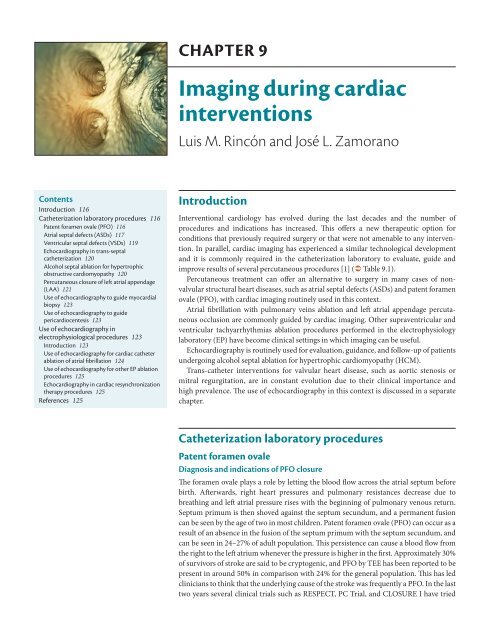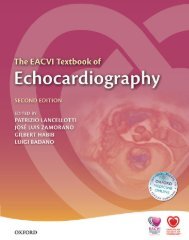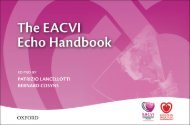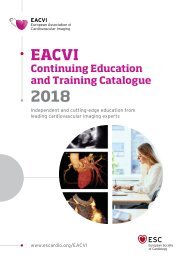ESC Textbook of Cardiovascular Imaging - sample
Discover the ESC Textbook of Cardiovascular Imaging 2nd edition
Discover the ESC Textbook of Cardiovascular Imaging 2nd edition
Create successful ePaper yourself
Turn your PDF publications into a flip-book with our unique Google optimized e-Paper software.
Chapter 9<br />
<strong>Imaging</strong> during cardiac<br />
interventions<br />
Luis M. Rincón and José L. Zamorano<br />
Contents<br />
Introduction 116<br />
Catheterization laboratory procedures 116<br />
Patent foramen ovale (PFO) 116<br />
Atrial septal defects (ASDs) 117<br />
Ventricular septal defects (VSDs) 119<br />
Echocardiography in trans-septal<br />
catheterization 120<br />
Alcohol septal ablation for hypertrophic<br />
obstructive cardiomyopathy 120<br />
Percutaneous closure <strong>of</strong> left atrial appendage<br />
(LAA) 121<br />
Use <strong>of</strong> echocardiography to guide myocardial<br />
biopsy 123<br />
Use <strong>of</strong> echocardiography to guide<br />
pericardiocentesis 123<br />
Use <strong>of</strong> echocardiography in<br />
electrophysiological procedures 123<br />
Introduction 123<br />
Use <strong>of</strong> echocardiography for cardiac catheter<br />
ablation <strong>of</strong> atrial fibrillation 124<br />
Use <strong>of</strong> echocardiography for other EP ablation<br />
procedures 125<br />
Echocardiography in cardiac resynchronization<br />
therapy procedures 125<br />
References 125<br />
Introduction<br />
Interventional cardiology has evolved during the last decades and the number <strong>of</strong><br />
procedures and indications has increased. This <strong>of</strong>fers a new therapeutic option for<br />
conditions that previously required surgery or that were not amenable to any intervention.<br />
In parallel, cardiac imaging has experienced a similar technological development<br />
and it is commonly required in the catheterization laboratory to evaluate, guide and<br />
improve results <strong>of</strong> several percutaneous procedures [1] ( Table 9.1).<br />
Percutaneous treatment can <strong>of</strong>fer an alternative to surgery in many cases <strong>of</strong> nonvalvular<br />
structural heart diseases, such as atrial septal defects (ASDs) and patent foramen<br />
ovale (PFO), with cardiac imaging routinely used in this context.<br />
Atrial fibrillation with pulmonary veins ablation and left atrial appendage percutaneous<br />
occlusion are commonly guided by cardiac imaging. Other supraventricular and<br />
ventricular tachyarrhythmias ablation procedures performed in the electrophysiology<br />
laboratory (EP) have become clinical settings in which imaging can be useful.<br />
Echocardiography is routinely used for evaluation, guidance, and follow-up <strong>of</strong> patients<br />
undergoing alcohol septal ablation for hypertrophic cardiomyopathy (HCM).<br />
Trans-catheter interventions for valvular heart disease, such as aortic stenosis or<br />
mitral regurgitation, are in constant evolution due to their clinical importance and<br />
high prevalence. The use <strong>of</strong> echocardiography in this context is discussed in a separate<br />
chapter.<br />
Catheterization laboratory procedures<br />
Patent foramen ovale<br />
Diagnosis and indications <strong>of</strong> PFO closure<br />
The foramen ovale plays a role by letting the blood flow across the atrial septum before<br />
birth. Afterwards, right heart pressures and pulmonary resistances decrease due to<br />
breathing and left atrial pressure rises with the beginning <strong>of</strong> pulmonary venous return.<br />
Septum primum is then shoved against the septum secundum, and a permanent fusion<br />
can be seen by the age <strong>of</strong> two in most children. Patent foramen ovale (PFO) can occur as a<br />
result <strong>of</strong> an absence in the fusion <strong>of</strong> the septum primum with the septum secundum, and<br />
can be seen in 24–27% <strong>of</strong> adult population. This persistence can cause a blood flow from<br />
the right to the left atrium whenever the pressure is higher in the first. Approximately 30%<br />
<strong>of</strong> survivors <strong>of</strong> stroke are said to be cryptogenic, and PFO by TEE has been reported to be<br />
present in around 50% in comparison with 24% for the general population. This has led<br />
clinicians to think that the underlying cause <strong>of</strong> the stroke was frequently a PFO. In the last<br />
two years several clinical trials such as RESPECT, PC Trial, and CLOSURE I have tried





